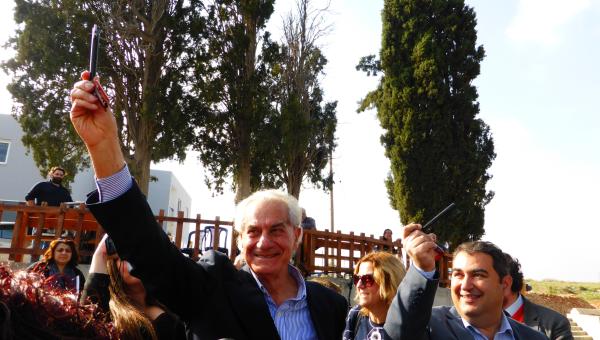Phase 3
[Closed] Support to Monuments of Great Importance for the Communities of Cyprus
| Status: | Closed |
| Duration: | 2014 - 2018 |
| Donors: | European Commission, Government of Cyprus |
| Coverage: | Island-wide |
| Beneficiaries: | Turkish Cypriot Community and Greek Cypriot Community |
| Focus Area: | Governance and Peacebuilding |
| Partners: | Technical Committee on Cultural Heritage |
| See more information about the project on the transparency portal. | |
Project Summary:
“The Cultural Heritage Technical Committee believes that it is the primary responsibility of Greek Cypriots and Turkish Cypriots to protect the endangered cultural heritage of the island, and that it is important for these monuments to be preserved, not only because they are important symbols for both Turkish Cypriots and Greek Cypriots, as well as for humanity, but also because they have an intrinsic value of their own.” (Press statement of the Technical Committee on Cultural Heritage, 06 May 2009).
The Agreement of 21 March 2008 reached between Greek Cypriots and Turkish Cypriots under the auspices of the United Nations (UN), paved the way for the establishment of the Technical Committee on Cultural Heritage, dedicated to the recognition, promotion and protection of the rich and diverse cultural heritage of Cyprus. The Committee is supported in its work by an Advisory Board composed of archaeologists, architects, art historians and town planners from both communities. All its programmatic decisions are taken in line with the agreed principles and the task attributed to them by the two Leaders.
The Technical Committee on Cultural Heritage works to provide a mutually acceptable mechanism for the implementation of practical measures for the proper preservation, physical protection and restoration (including research, study and survey) of the cultural heritage of Cyprus. The Committee believes that the protection of cultural heritage is an integral part of the ongoing process of broadening areas of cooperation between Greek Cypriots and Turkish Cypriots, which can most effectively be achieved through joint efforts. The protection of cultural heritage also stimulates sustainable development and mutual understanding.
An initial list of 40 sites in need of emergency care and conservation was approved by the Leaders. Additional monuments of great historical value or notable size have been added to this list. Particular attention was given to the archaeological importance of the monuments, reflecting their uniqueness, historical significance and role in society as well as their future educational role.
Objectives
To support the reconciliation process and to increase the trust between the Greek Cypriot and Turkish Cypriot communities through the implementation of confidence building measures agreed by the Technical Committee on Cultural Heritage (TCCH).
Preservation of Cypriot cultural heritage by supporting restoration and emergency measures for high importance monuments agreed by the Technical Committee on Culture in Cyprus.
Implementing Partners:
Since 2010 the United Nations Development Programme (UNDP) has assisted the Technical Committee on Cultural Heritage to preserve the cultural heritage of Cyprus.
UNDP directly implements and administers the Committee's conservation works and visibility efforts, hence creating a favourable environment for the non-political consideration of cultural heritage on both sides of the island.
Joint monitoring visits and regular meetings with the Advisory Board of the Technical Committee are facilitated by UNDP to encourage and ensure the direct involvement in each stage of the project cycle. The direct involvement of technical teams from both communities (architects, archaeologists, engineers etc.) act, in time, as team- and confidence-building measures, allowing for increased exchange of experiences and the setting of a positive example of successful collaboration between Greek Cypriots and Turkish Cypriots.
Moreover, UNDP provides logistical and strategic support to the Technical Committee on Cultural Heritage in its efforts to re-establish community links between villages and their former residents and encourage cross-community exchanges.
Results
Within Phase 3 of the project, the following 20 cultural heritage sites located island-wide benefited from emergency measures and/or conservation projects and designs:
Designs for future conservation projects prepared for the following sites
sites located in the Karpasia/Karpaz area: Agia Triada Basilica & Baptistery and Afendrika archaeological site (including Agios Georgios church), Agios Philon archaeological site;
sites located in the Paphos area: the Hamam/Bath (near Hasan Aga tomb), the minaret of the Camii-Kebir mosque and the mosques in Agios Nikolaos/Aynikola and Agios Ioannis/Ayanni;
sites located in the Famagusta area: St. Anne of the Maronites church, St. Mary of the Armenians church, St. Mary of Carmel church, Tanners mosque;
- Archangelos Michail Church in Lefkonikou/Gecitkale.
Conservation works conducted on
Economic Value and Sustainability study for the monuments of Famagusta
With 16 conservation/emergency measures projects already completed during Phase 1 and Phase 2 of the project, ensuring sustainability and maintenance of the works done became imperative in Phase 3 of the project. To address this need, an “Economic Value and Sustainability Study” was carried out in 2016. The case study focused on the Famagusta area, where a significant investment has been made by the Technical Committee on Cultural Heritage, thanks to the support of the European Union, to preserve the Walled City's cultural heritage (Othello Tower, City Walls, Ravelin Land Gate and Martinengo Bastion and cluster of churches). The results of this Study will be used by the Technical Committee on Cultural Heritage to develop its future strategy for Famagusta.
Engaging local communities through Small Project Activities (SPA)
The Small Project Activities (SPA) initiative focuses on grassroots, low-cost interventions on monuments requiring simple, small-scale works capable of producing early results and bringing local communities closer to the work of the Technical Committee on Cultural Heritage. Examples of Small Project Activities include:
internal and external site cleaning;
removal of vegetation from roofs and walls;
minor repairs;
replacement of doors, fences and windows at heritage sites.

 Locations
Locations




